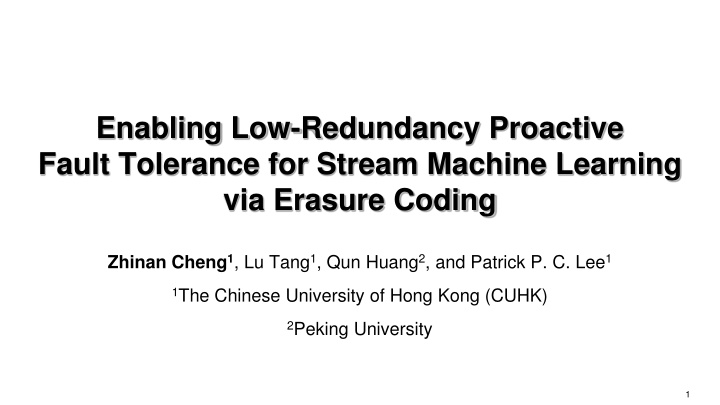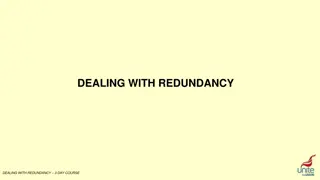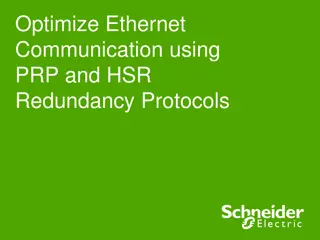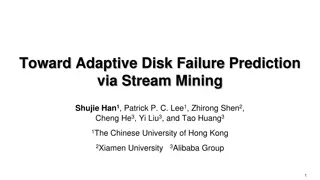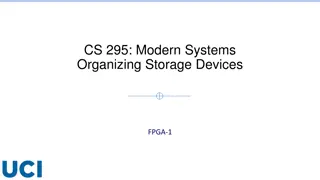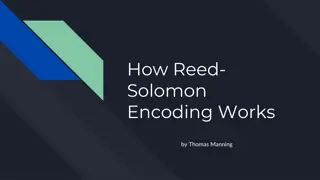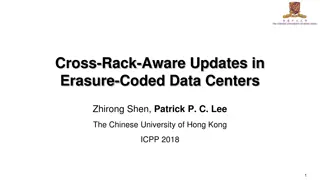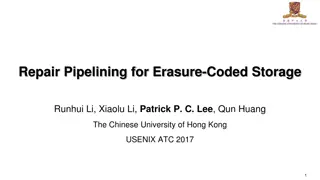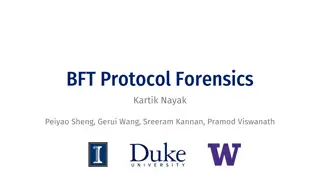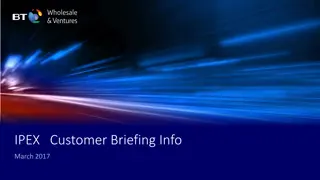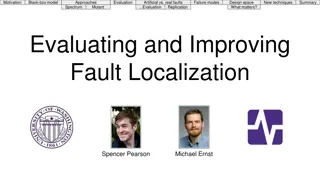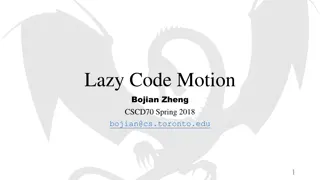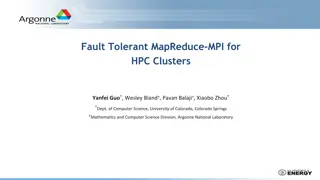Low-Redundancy Proactive Fault Tolerance for Stream Machine Learning
This study focuses on enabling fault tolerance for stream machine learning through erasure coding. Fault tolerance is crucial in distributed environments due to worker failures, and existing approaches like reactive fault tolerance and proactive replication have drawbacks. The use of erasure coding with Reed-Solomon codes is proposed to provide low-redundancy fault tolerance. This method can tolerate multiple failures and has lower overhead compared to replication. The study emphasizes the importance of fast failure recovery for real-time responses in stream processing.
Uploaded on Nov 19, 2024 | 2 Views
Download Presentation

Please find below an Image/Link to download the presentation.
The content on the website is provided AS IS for your information and personal use only. It may not be sold, licensed, or shared on other websites without obtaining consent from the author.If you encounter any issues during the download, it is possible that the publisher has removed the file from their server.
You are allowed to download the files provided on this website for personal or commercial use, subject to the condition that they are used lawfully. All files are the property of their respective owners.
The content on the website is provided AS IS for your information and personal use only. It may not be sold, licensed, or shared on other websites without obtaining consent from the author.
E N D
Presentation Transcript
Enabling Low-Redundancy Proactive Fault Tolerance for Stream Machine Learning via Erasure Coding Zhinan Cheng1, Lu Tang1, Qun Huang2, and Patrick P. C. Lee1 1The Chinese University of Hong Kong (CUHK) 2Peking University 1
Stream Machine Learning Stream machine learning Use of machine learning for continuous streams of data items Special case of stream processing Critical for online advertising and real-time recommendation Large-scale deployment of stream machine learning Distributed stream processing systems (DSPS) Across different operators that are executed by multiple workers 2
Fault Tolerance Fault tolerance is critical for stream machine learning Failures are prevalent in distributed environments Workers unexpectedly crash and lose all states Unique aspects of fault tolerance of stream processing Infeasible to track and replay all dependent items for failure recovery Main memory supports fast processing but is vulnerable to data loss Fast failure recovery for real-time responses 3
Fault Tolerance Existing approaches for fault tolerance in DSPS Reactive fault tolerance Triggers failure recovery upon the detection of failures Issues periodic backups for both states and items to persistent storage Restores the latest backup and replays items in new workers Significant disk I/O, disturbing normal performance Non-zero recovery latency Proactive replication Issues multiple replicas of each item to different workers for concurrent execution Prohibitively expensive 4
Recovery Overhead Recovery overhead of DSPS: Spark Streaming and Flink Spark Streaming incurs high recovery latency due to high restore time Flink incurs high recovery overhead due to high restart time Spark Streaming Flink 5
Erasure Coding Erasure coding for low-redundancy proactive fault tolerance For (k,r) Reed-Solomon (RS) codes Encode k uncoded streaming data item into r parity items Can reconstruct original k data items using any k out of k + r data/parity items Can tolerate any r failures Example (2,2) RS code for tolerating 2 failures 2X overhead for RS code 3X overhead for replication 6
Coded Computation Coded computation A special case of applying erasure coding for fault tolerance in distributed computations Applicable for linear operations Apply linear operations to all k + r data and parity items Operation outputs of k data items can be reconstructed from any k out of the k + r operation outputs of data/parity items Cannot support non-linear operations 7
Challenges Challenges for applying erasure coding to stream machine learning: Practical erasure coding constructions mainly build on linear operations on data units, but non-linear operations are common in stream machine learning Continuous real-time nature of stream machine learning requires highly efficient coding operations for low-latency responses 8
Contributions StreamLEC: a stream machine learning system with erasure coding to provide low-redundancy proactive fault tolerance and immediate failure recovery A streaming workflow with an extensible programming model Erasure-coded fault tolerance Supports general stream machine learning applications Incremental encoding and hybrid coded computation Effectively mitigate computational and communicational overhead of erasure coding Extensive evaluation on both a local cluster and Amazon EC2 9
StreamLEC Architecture Source: Splits data streams into micro-batches Encodes and distributes items to processors Processor: Receives data or parity items from one or multiple sources Executes user-defined operators on each received data item Emits outputs to one or multiple sinks Sink: Reconstructs processing results of k data items from any k out of k+r processor outputs Returns feedbacks to processors and ACKs to the source 10
Programming Model StreamLEC s programming model provides two types of interfaces: Communication interfaces: Construct the message workflow among different workers User-defined interfaces Extensible and allow programmers to add implementation details for specific machine learning applications The streaming workflow ensures that any application implemented with user-defined interfaces achieves erasure-coded fault tolerance 11
Streaming Workflow Encoding workflow executed by a source: Encodes and sends both data and parity items to k + r processors Processing workflow executed by a processor: For data items, generates results with user-defined operators, emits the results to the sink, and attaches input data items to the emitted output For parity items, directly sends them to a sink Decoding workflow executed by a sink: Receives processing results, also data/parity items If any result unavailable, decodes the corresponding data items and recomputes results 12
Incremental encoding Main ideas: Per-data-item basis rather than per-micro-batch basis Pipelines encoding operations and transmissions of data items to mitigate computational overhead of erasure coding Insights A parity item is a linear combination of k data item, e.g., parity item ? = ?0?0+ ?1?1+ ?2?2, where ?0?1?2 are data item, ?0?1?2 are encoding parameters When ?0 available, compute ? = ?0?0 and send ?0 When ?1 available, compute ? = ? + ?1?1 and send ?1 When ?2 available, compute Y = ? + ?2?2 and send ?2 and Y 13
Hybrid Coded Computation Main ideas: Performs coded computation on linear components and normal (uncoded) computation on the non-linear components to mitigate communication overhead Workflow: Decompose computation into linear and non-linear components Assume linear component runs before non-linear components For data item, compute and send results, attach output of linear component For parity item, compute and send the output of linear component The sink can reconstruct any non-linear results using any k out of k + r linear results Recall that originally a processor attaches input data items (vector) to the emitted outputs. We now only attach the linear results (scalar) 14
Evaluation Prototype StreamLEC in C++, with 19000 LOC Two real-world dataset: KDD12 Cup and HIGGS Algorithms Linear regression, Logistic regression, SVM, K-Means Schemes Rep-2X and Rep-3X, Reactive (Checkpointing), and SteramLEC with EC (5,1) and EC(4,2) 15
Evaluation Throughput in normal mode StreamLEC significantly outperforms Reactive and Replication EC(4,2) achieves 5.17X and 1.55X throughput over Reactive and Rep-3x, respectively K-Means, HIGGS Logistic regression, KDD12 16
Evaluation Failure recovery StreamLEC (i.e., EC(5,1) and EC(4,2)) have negligible latency differences before and after failure recovery. Reactive incurs 8.9 and 14 increases of processing latency after single- fault recovery and double-fault recovery, respectively 17
Evaluation Scalability on Amazon EC2 Both StreamLEC and Rep-3x scale linearly with number of source/sink pairs StreamLEC s throughput increases with the number of processors while Replication cannot 18
Conclusion StreamLEC: Providing low-redundancy proactive fault tolerance and immediate failure recovery via erasure coding Supporting general stream machine learning applications Evaluation on both local clusters and Amazon EC2 StreamLEC significantly outperforms both reactive and replication-based fault tolerance approaches with negligible failure recovery overhead Source code: http://adslab.cse.cuhk.edu.hk/software/streamlec/ 19
Thank You! Q & A 20
